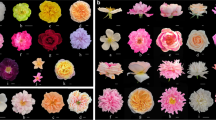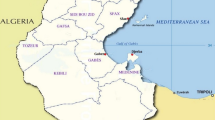Abstract
A strategy was proposed for constructing core collections by least distance stepwise sampling (LDSS) based on genotypic values. In each procedure of cluster, the sampling is performed in the subgroup with the least distance in the dendrogram during constructing a core collection. Mean difference percentage (MD), variance difference percentage (VD), coincidence rate of range (CR) and variable rate of coefficient of variation (VR) were used to evaluate the representativeness of core collections constructed by this strategy. A cotton germplasm collection of 1,547 accessions with 18 quantitative traits was used to construct core collections. Genotypic values of all quantitative traits of the cotton collection were unbiasedly predicted based on mixed linear model approach. By three sampling percentages (10, 20 and 30%), four genetic distances (city block distance, Euclidean distance, standardized Euclidean distance and Mahalanobis distance) combining four hierarchical cluster methods (nearest distance method, furthest distance method, unweighted pair-group average method and Ward’s method) were adopted to evaluate the property of this strategy. Simulations were conducted in order to draw consistent, stable and reproducible results. The principal components analysis was performed to validate this strategy. The results showed that core collections constructed by LDSS strategy had a good representativeness of the initial collection. As compared to the control strategy (stepwise clusters with random sampling strategy), LDSS strategy could construct more representative core collections. For LDSS strategy, cluster methods did not need to be considered because all hierarchical cluster methods could give same results completely. The results also suggested that standardized Euclidean distance was an appropriate genetic distance for constructing core collections in this strategy.

Similar content being viewed by others
References
Balakrishnan R, Nair NV, Screenivasan TV (2000) A method for establishing a core collection of Saccharum officinarum L.germplasm based on quantitative-morphological data. Genet Resour Crop Evol 47:1–9
Baranger A, Aubert G, Arnau G, Laine AL, Deniot G, Potier J, Weinachter C, Lejeune-Hénaut I, Lallemand J, Burstin J (2004) Genetic diversity within Pisum sativum using protein- and PCR-based markers. Theor Appl Genet 108:1309–1321
Brown AHD (1989) Core collection: a practical approach to genetic resources management. Genome 31:818–824
Chabane JCK, Valkoun J (2004) Characterisation of genetic diversity in ICARDA core collection of cultivated barley (Hordeum vulgare L.). Czech J Genet Plant Breed 40:134–136
Chandra S, Huaman Z, Hari Krishna S, Ortiz R (2002) Optimal sampling strategy and core collection size of Andean tetraploid potato based on isozyme data—a simulation study. Theor Appl Genet 104:1325–1334
Frankel OH (1984) Genetic perspectives of germplasm conservation. In: Arber WK, Llimensee K, Peacock WJ, Starlinger P (eds) Genetic manipulation: impact on man and society. Cambridge University Press, Cambridge, pp 161–170
Frankel OH, Brown AHD (1984a) Current plant genetic resources—a critical appraisal. In: Chopra VL, Joshi BC, Sharma RP, Bansal HC (eds) Genetics: new frontiers, vol 4. Oxford and IBH, New Delhi, pp 1–11
Frankel OH, Brown AHD (1984b) Plant genetic resources today: a critical appraisal. In: Hoden HW, Williams JT (eds) Crop genetic resources: conservation and evaluation. George Allen and Urwin, London, pp 249–257
Fundora MZ, Hernandez M, Lopez R, Fernandez L, Sanchez A, Lopez J, Ravelo I (2004) Analysis of the variability in collected peanut (Arachis hypogaea L.) cultivars for the establishment of core collections. Plant Genet Res Newsl 137:9–13
van Hintum ThJL (1995) Hierarchical approaches to the analysis of genetic diversity in crop plants. In: Hodgkin T, Brown AHD, van Hintum ThJL, Morales EAV (eds) Core collections of plant genetic resources. Wiley, Chichester, pp 23–34
Hu J, Xu HM, Zhu J (2000a) Constructing core collection of crop germplasm by multiple clusters based on genotypic values. J Biomath 15:103–109
Hu J, Xu HM, Zhu J (2000b) A method of constructing core collection reserving special germplasm materials. J Biomath 16:348–352
Hu J, Zhu J, Xu HM (2000c) Methods of constructing core collections by stepwise clustering with three sampling strategies based on the genotypic values of crops. Theor Appl Genet 101:264–268
Li CT, Shi CH, Wu JG, Xu HM, Zhang HZ, Ren YL (2004) Methods of developing core collections based on the predicted genotypic value of rice (Oryza sativa L.). Theor Appl Genet 108:1272–1176
Tanksley SD, McCouch SR (1997) Seed bank and molecular maps: Unlocking genetic potential from the wild. Science 277:1063–1066
Upadhyaya HD, Ortiz R (2001) A mini core subset for capturing diversity and promoting utilization of chickpea genetic resources in crop improvement. Theor Appl Genet 102:1292–1298
Volk GM, Richards CM, Reilley AA, Henk AD, Forsline PL, Aldwinckle HS (2005) Ex situ conservation of vegetatively propagated species: development of a seed-based core collection for Malus sieversii. J Am Soc Hortic Sci 130:203–210
Yang WQ, Liu LT, Lin HZ (1989) Multivariate statistical analysis. Higher Education Press, Beijing, pp 205–226
Yonezawa K, Nomura T, Morishima H (1995) Sampling strategies for use in stratified germplasm collections. In: Hodgkin T, Brown AHD, van Hintum ThJL, Morales EAV (eds) Core collections of plant genetic resources. Wiley, Chichester, pp 35–53
Zewdie Y, Tong NK, Bosland P (2004) Establishing a core collection of Capsicum using a cluster analysis with enlightened selection of accessions. Genet Resour Crop Evol 51: 147–151
Zhang X, Zhao Y, Cheng Y, Feng X, Guo Q, Zhou M, Hodgkin T (2000) Establishment of sesame germplasm core collection in China. Genet Resour Crop Evol 47:273–279
Zhang GY, Wang XF, Liu SJ, Ma ZY (2004) Cluster analysis and sampling methods for core collection construction in glandless cotton. Cotton Sci 16:8–12
Zhu J (1993) Methods of prediction genotype value and heterosis for offspring of hybrids. J Biomath 8:32–44
Zhu J, Weir BS (1996) Diallel analysis for sex-linked and maternal effects. Theor Appl Genet 92:1–9
Acknowledgment
The research was supported by the National Natural Science Foundation of China (No. 30270759).
Author information
Authors and Affiliations
Corresponding author
Additional information
Communicated by H. Becker.
Rights and permissions
About this article
Cite this article
Wang, J.C., Hu, J., Xu, H.M. et al. A strategy on constructing core collections by least distance stepwise sampling. Theor Appl Genet 115, 1–8 (2007). https://doi.org/10.1007/s00122-007-0533-1
Received:
Accepted:
Published:
Issue Date:
DOI: https://doi.org/10.1007/s00122-007-0533-1




